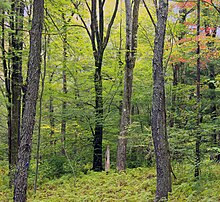31:
171:, it is regrowth following centuries of commercial timber harvesting and the clearing of land for agricultural purposes. This is particularly true of New England, New York, and Eastern Canada, where the land was cleared to make room for farms in the 17th and 18th centuries and subsequently abandoned in the 19th century when farming interests migrated to the midwestern United States and central Canada.
293:
318:
298:
94:
community to the north. The trees and shrub species of the
Northern Hardwood Forest are known for their brilliant fall colors, making the regions that contain this forest type popular
232:
247:
218:, typically between 4,500 feet (1,400 m) and 5,500 feet (1,700 m), where climatic conditions resemble those in northern states and southern Canada.
313:
303:
328:
83:
214:
is very typical of a
Northern Hardwood Forest ecosystem. Northern hardwood stands are also found in the higher elevations of the southern
227:
187:
183:
308:
237:
288:
242:
35:
323:
30:
333:
174:
The
Northern Hardwood Forest is indigenous to several well-known parks and national forests, including the
116:
are the common key indicator tree and shrub species in the
Northern Hardwood Forest. Other species include
141:
137:
161:
215:
195:
199:
121:
113:
87:
191:
157:
129:
117:
63:
179:
175:
109:
282:
211:
203:
168:
153:
145:
91:
55:
47:
105:
95:
67:
17:
133:
125:
101:
71:
59:
207:
149:
75:
266:
Changes in the Land: Indians, Colonists, and the
Ecology of New England
136:. Birds and animals common to the Northern Hardwood Forest include the
79:
51:
50:
forest ecosystem found over much of southeastern and south-central
29:
294:
Temperate broadleaf and mixed forests in the United States
54:, Ontario, and Quebec, extending south into the
319:Flora of the Great Lakes region (North America)
299:Temperate broadleaf and mixed forests in Canada
86:because it contains species common to both the
8:
233:Appalachian hemlock–northern hardwood forest
167:Most of the Northern Hardwood Forest is not
248:Temperate broadleaf and mixed forests
7:
314:Flora of the Appalachian Mountains
34:Austin T. Blakeslee Natural Area,
25:
275:. Houghton-Mifflin, Boston, 1998.
124:. Herb and heath species include
273:A Field Guide to Eastern Forests
268:. Hill and Wang, New York, 2003.
178:region of Minnesota, New York's
82:. Some ecologists consider it a
304:Ecoregions of the United States
90:community to the south and the
27:North American forest ecosystem
188:Green Mountain National Forest
184:White Mountain National Forest
1:
238:Central U.S. hardwood forests
329:Forests of the United States
243:New England/Acadian forests
36:Monroe County, Pennsylvania
350:
44:northern hardwood forest
228:Hardwood forest plants
186:in New Hampshire, the
142:white-throated sparrow
138:black-capped chickadee
98:tourist destinations.
39:
162:American red squirrel
70:, and west along the
46:is a general type of
33:
309:Ecoregions of Canada
216:Blue Ridge Mountains
196:Acadia National Park
289:Appalachian forests
200:Fundy National Park
84:transitional forest
210:region of western
122:eastern white pine
88:oak-hickory forest
40:
324:Forests of Canada
264:Cronon, William.
192:Baxter State Park
158:white-tailed deer
130:wild sarsaparilla
18:Northern hardwood
16:(Redirected from
341:
21:
349:
348:
344:
343:
342:
340:
339:
338:
279:
278:
271:Kircher, John.
261:
259:Further reading
256:
224:
180:Adirondack Park
176:Boundary Waters
118:eastern hemlock
28:
23:
22:
15:
12:
11:
5:
347:
345:
337:
336:
334:Forest ecology
331:
326:
321:
316:
311:
306:
301:
296:
291:
281:
280:
277:
276:
269:
260:
257:
255:
252:
251:
250:
245:
240:
235:
230:
223:
220:
198:in Maine, and
110:American beech
48:North American
26:
24:
14:
13:
10:
9:
6:
4:
3:
2:
346:
335:
332:
330:
327:
325:
322:
320:
317:
315:
312:
310:
307:
305:
302:
300:
297:
295:
292:
290:
287:
286:
284:
274:
270:
267:
263:
262:
258:
253:
249:
246:
244:
241:
239:
236:
234:
231:
229:
226:
225:
221:
219:
217:
213:
212:Massachusetts
209:
205:
204:New Brunswick
201:
197:
193:
189:
185:
181:
177:
172:
170:
169:virgin forest
165:
163:
159:
155:
154:snowshoe hare
151:
147:
146:cedar waxwing
143:
139:
135:
131:
127:
123:
119:
115:
111:
107:
103:
99:
97:
93:
92:Boreal forest
89:
85:
81:
77:
73:
69:
65:
61:
57:
56:United States
53:
49:
45:
37:
32:
19:
272:
265:
190:in Vermont,
173:
166:
106:yellow birch
100:
96:fall foliage
78:and western
68:Pennsylvania
58:in northern
43:
41:
134:wood sorrel
126:wintergreen
102:Sugar maple
72:Great Lakes
60:New England
283:Categories
254:References
208:Berkshires
150:porcupine
114:white ash
76:Minnesota
222:See also
64:New York
80:Ontario
206:. The
182:, the
160:, and
132:, and
112:, and
66:, and
52:Canada
194:and
120:and
42:The
202:in
74:to
285::
164:.
156:,
152:,
148:,
144:,
140:,
128:,
108:,
104:,
62:,
38:.
20:)
Text is available under the Creative Commons Attribution-ShareAlike License. Additional terms may apply.
